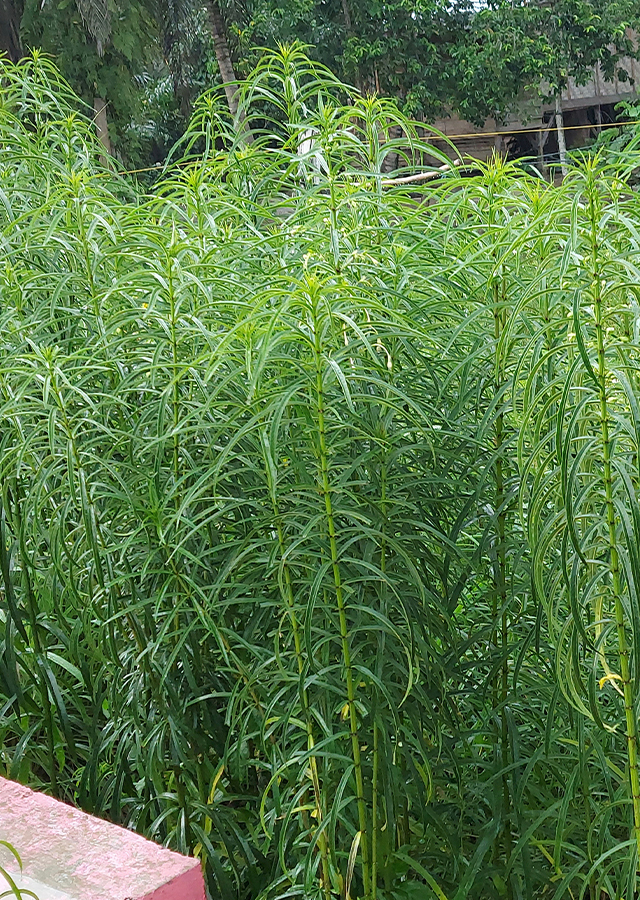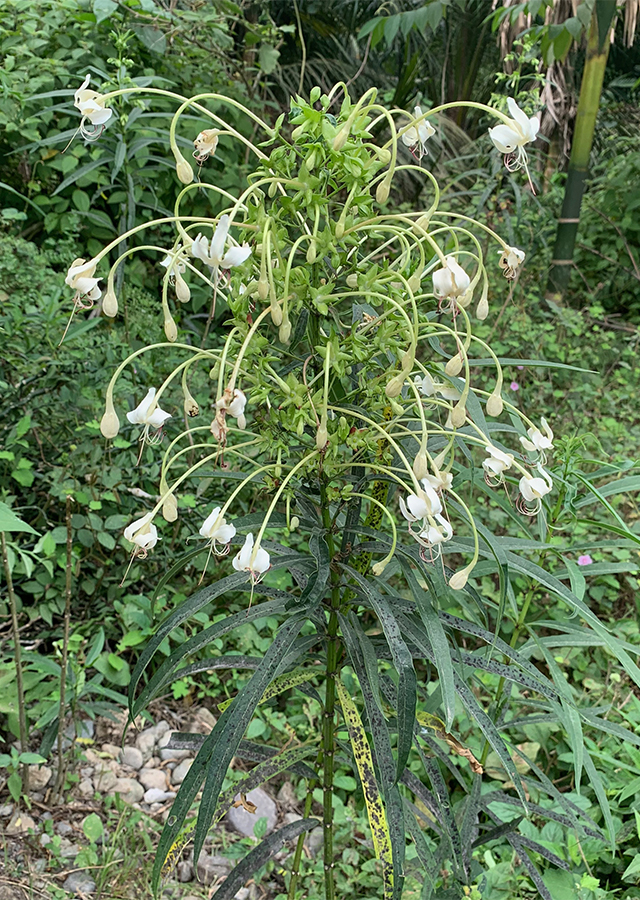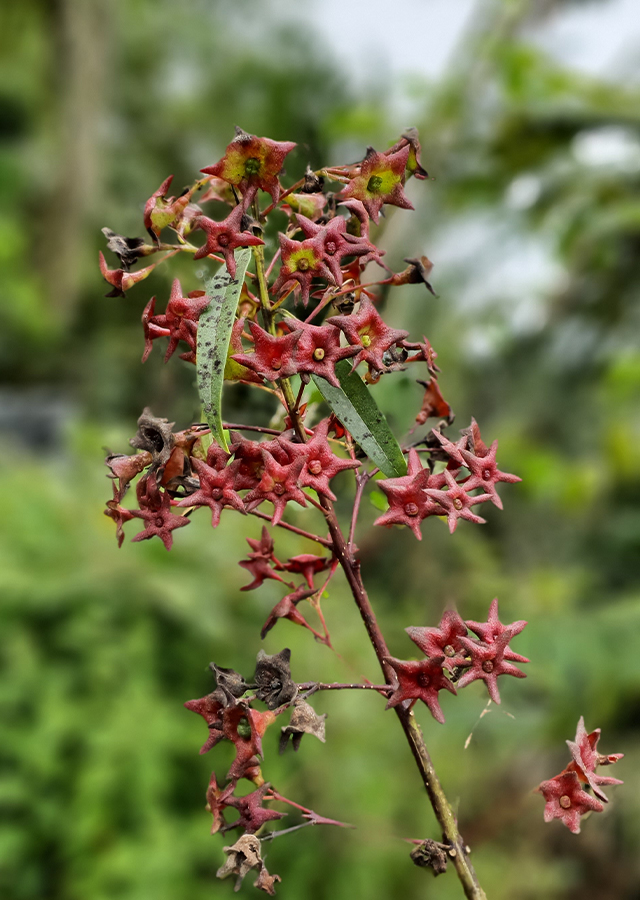Turk's Turban
Clerodendrum indicum (L.) Kuntze
Lamiaceae
Location in our garden
Principal



Synonym
Clerodendrum longicolle G.Mey.
Clerodendrum mite (L.) Vatke
Clerodendrum semiserratum Wall.
Habitus
Shrubs. The semideciduous perennial or semi-woody shrub grows up to 3 m tall, ornamental flowers. Pollination is entomophilous i.e., by insects.
Part Used
Leaves
Roots
Resin
Growing Requirements
Full Sunshine
Need Shade
Habitat
Riverbanks
Forest
Roadside
Rocky Areas
Overview
Turk's turban is considered to be native to India and Nepal, eastward to Myanmar, southern China, Indo-China, Thailand and Peninsular Malaysia. The plant is commonly used as a standard drug in India and harvested from the wild for local use as medicine. It is often grown as an ornamental.
Vernacular Names
Penatoh (Malay), Leng chon tai (Thai), Ngayan-padu (Myanmar), Bharangi (India), Chang guan da qing (Chinese).
Agroecology
Found in roadsides on mountain slopes; at elevations from 500-1,000 m. It can tolerate a wide range of soil types, but prefers moist but well-drained soil and partial shade to full sun. It has low tolerance for salt but is fairly drought-resistant.
Morphology
- Roots - light brown in color and more than 2.5 cm in diameter.
- Stems - very straight or arching, mostly unbranched, hollow, subglabrous, virgate, nodes annulate.
- Leaves - linear-lanceolate to oblanceolate, base attenuate to acute, apex acute or acuminate, mostly entire, glabrous on both surfaces. The leaf margin is dentate (toothed)
- Flowers - bisexual, waxy, terminal panicle up to 45 cm × 25 cm, composed of 3-12 whorls of cymes; calyx very broadly campanulate, tube 5-7 mm long, green or red, corolla hypocrateriform, tube long and slender, white to yellow, showy, not fragrant, stamens long exserted, purple.
- Fruits - 1-1.3 cm in diameter with 4 pyrenes, fleshy, bright green turning blue-black or reddish-black.
Cultivation
- By seeds - best sown as soon as it is ripe. Germination can be erratic but usually takes place within 20-60 days at 20 °C. When large enough to handle, prick the seedlings out into individual pots and grow them on until large enough to plant out.
- By root cuttings: 6- 8 cm long.
- By division.
Chemical Constituents
Hydroquinone, diterpenoid, clerodendrone, alkaloid, resin, cholesterol, beta-sitosterol,, manitol, sorbitol, steroid, flavanoid, tannin, saponin, dihydroxyphenylethanol, hispidulin, glucuronide, eupafolin, scutellarein, clerodendrol, roseoside and lariciresinol 9-O-β-D-glucoside.
Traditional Medicinal Uses
- The root is stomachic, expectorant, anti-inflammatory, anti-bronchitis, febrifuge, hence useful for asthma, cough, and scrofulous affection.
- The leaves are used as a bitter tonic, to treat cough and vermifuge.
- The juice of the tender parts of the plant is used as an external application for skin complaints.
- The pounded root, combined with ginger, is considered useful in the treatment of asthma, coughs and other pulmonary complaints as well as scrofulous affections.
- The leaves and the roots are used externally to treat tumours and certain skin diseases.
- The root increases appetite and lowers fever (Unani medicine).
- In New Caledonia, the leaves are used as a bitter tonic and vermifuge.
- In Burma (Myanmar), resin from the plant is employed for syphilitic rheumatism.
- In Java (Indonesia), dried leaves are rolled into cigarettes to relieve asthma
Part Used
Reference Sources
- CABI. (No date). Invasive Species Compendium. Clerodendrum indicum. https://www.cabi.org/isc/datasheet/14330. 22-02-2021
- Fern, Ken. (2014). Useful Tropical Plant. Clerodendrum indicum. http://tropical.theferns.info/viewtropical.php?id=Clerodendrum+indicum 22-02-2021
- J.L.C.H. van Valkenburg & N. Bunyapraphatsara. (2016). Pl@nt Use. Clerodendrum indicum. https://uses.plantnet-project.org/en/Clerodendrum_indicum_(PROSEA) 22-02-2021
- Europe PMC. (1999). Clerodendrum indicum. https://europepmc.org/article/cba/321708 22-02-2021
- Vikaspedia. (No date). Clerodendrum indicum. https://vikaspedia.in/agriculture/crop-production/package-of-practices/medicinal-and-aromatic-plants/clerodendrum-indicum#:~:text=Roots%20and%20leaves-,Therapeutic%20uses,tumours%20and%20certain%20skin%20diseases. 22-02-2021
- International Journal of Indigenous Herbs and Drugs. (2018). A Brief Review on Clerodendrum indicum. https://www.saapbooks.com/journals/index.php/herbsanddrugs/article/view/79 22-02-2021